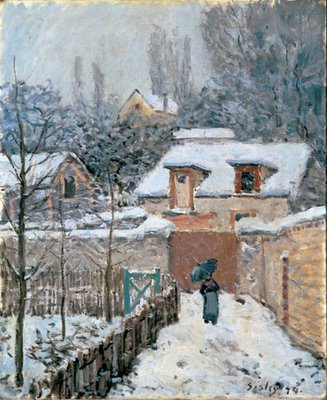 One of the best things about being a teacher (besides the edification of young minds, of course) is the snow day, and when Washington gets anything more than a dusting of snow (and sometimes even just the threat of snow), I get to sleep in and read all day long. (See Alfred Sisley's appreciation of fallen snow to the right, Jardin à Louveciennes - effet de neige, from 1874.) So, after shoveling the 6 to 8 inches of white stuff from the sidewalk this morning, I stumbled across Blake Gopnik's article (Science, Trying to Pick Our Brains About Art, January 25) from the Sunday edition of the Washington Post. I know that this has already gotten coverage in Arts & Letters Daily and probably on every other artsblog, but you really should read it.
One of the best things about being a teacher (besides the edification of young minds, of course) is the snow day, and when Washington gets anything more than a dusting of snow (and sometimes even just the threat of snow), I get to sleep in and read all day long. (See Alfred Sisley's appreciation of fallen snow to the right, Jardin à Louveciennes - effet de neige, from 1874.) So, after shoveling the 6 to 8 inches of white stuff from the sidewalk this morning, I stumbled across Blake Gopnik's article (Science, Trying to Pick Our Brains About Art, January 25) from the Sunday edition of the Washington Post. I know that this has already gotten coverage in Arts & Letters Daily and probably on every other artsblog, but you really should read it.The ideas in the article come from scientific papers presented at the Third International Conference on Neuroesthetics, Emotions in Art and the Brain, held on January 10 at the Berkeley Art Museum, in California. To paraphrase Bill Murray: "Scientists, artists, and art historians conversing together: mass hysteria!" (Scientists, I know from personal experience working with them and having them as family members, are really a culture-sensitive lot, and they like to poke their heads out of their laboratories from time to time to get involved in art, music, and reading.) The research presented at the conference has to do with what happens in the brain when people create and experience art. When we get that figured out, perhaps a drug company somewhere will make a Ritalin cousin that worried parents can have administered to students when they have to take my Humanities course and display an aversion to learning about the history of art, literature, and music. Such a development would surely take half of the challenge and interest out of my teaching experience.
From scanning the papers at the conference, I found one of those that Gopnik did not mention, "Patterns that Connect—The Self-Organizing Landscape and the Brain," presented by Robert Steinberg, a former NASA scientist who has returned to earlier interests to work in art. Here is the abstract:
I will describe a new way to create art that evokes a rich variety of perceptions and emotions by using a medium that can self-organize and provide feedback. The evolving patterns reflect a natural order that invites artist participation and control, producing a sense of recognition in the brain that is heightened by the excitement of the unexpected. Most images are complex, nonrepeating, nonrandom and fractal—and are created by maintaining the medium as an open system far from equilibrium (energy and matter are added). Feelings of wonder during the act of painting, provide a robust, though temporary shield against self- doubt.I haven't been able to locate any online images of this type of art, but I will keep looking.
This approach to painting uses ideas from a new field in science called Soft Condensed Matter Physics. The dynamic qualities of soft matter seem to be tailor-made for art, conferring the spontaneous formation of coherent order and unprecedented flow properties on fluids. Artists now have a new way to challenge their imagination using an endless array of patterns that capture the aggregate artistry of nature. Aesthetically motivated curiosity, that most important stimulus to discovery for early artisans, may be about to make a comeback. I will show several slides of paintings that exemplify this new concept.